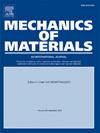软可压缩固体的切削力学。力-半径缩放与体积模量
IF 3.4
3区 材料科学
Q2 MATERIALS SCIENCE, MULTIDISCIPLINARY
引用次数: 0
摘要
由于软韧性材料在裂纹成核和扩展过程中具有复杂的行为,因此在软固体中切削力学是一个复杂的挑战。最近的研究探索了连续切割软材料所需的切削力与线材(刀片)半径之间的关系。一个典型的简化假设是物质不可压缩,尽管自然界中没有物质是真正不可压缩的。在本研究中,我们放宽了这一假设,并研究了材料的可压缩性如何影响切削力与材料特性(如韧性和模量)之间的相关性。μ/K表示材料的可压缩性,其中,μ和K分别为剪切模量和体积模量,不可压缩材料的μ/K=0,较大的μ/K表示较高的体积可压缩性。研究发现,切削力受切削丝半径Rw与材料的弹性黏合长度Le=Γ/μ的比值(与单轴拉伸下裂纹扩展时的临界裂纹张开位移成正比)控制,其中Γ为材料的韧性。根据之前的观察,我们有两种切割制度:(i)高Le/Rw(小电线),和(ii)低Le/Rw(大电线)。状态(i)主要是摩擦耗散,而状态(ii)主要是胶粘剂脱粘和/或材料的耐磨性。在大半径范围(ii)中,我们的理论发现表明不可压缩材料需要更大的力(例如,K=μ比不可压缩材料需要一半的力,K=μ),而在小半径范围(i)中,我们观察到相反的趋势。值得注意的是,(i)和(ii)之间的过渡线半径也取决于可压缩性,并且对于可压缩材料来说更大。因此,对于给定的导线半径,材料的可压缩性有利于摩擦控制。本文章由计算机程序翻译,如有差异,请以英文原文为准。
Cutting mechanics of soft compressible solids – Force-radius scaling versus bulk modulus
Cutting mechanics in soft solids present a complex challenge due to the intricate behavior of soft ductile materials as they undergo crack nucleation and propagation. Recent research has explored the relationship between the cutting force needed to continuously cut a soft material and the radius of the wire (blade). A typical simplifying assumption is that of material incompressibility, albeit no material in nature is really incompressible. In this study, we relax this assumption and examine how material (in)compressibility influences the correlation between cutting forces and material properties like toughness and modulus. The ratio , where and are the shear and bulk moduli, indicates the material's degree of compressibility, where incompressible materials have , and larger provide higher volumetric compressibility. We observe that the cutting forces are controlled by the ratio between the cutting wire radius and the elasto-cohesive length of the material (proportional to the critical crack opening displacement at crack propagation under uniaxial tension), where is the toughness of the material. Following previous observations, we have two cutting regimes: (i) high (small wire), and (ii) low (large wire). Regime (i) is dominated by frictional dissipation, while regime (ii) is dominated by adhesive debonding and/or the wear resistance of the material. In the large radius regime (ii), our theoretical findings reveal that incompressible materials require larger forces (e.g., requiring half force compared to incompressible, ), while in the small radius regime (i) we observe the opposite trend. Notably, the transition wire radius between regimes (i) and (ii) also depend on compressibility, and is larger for compressible materials. Thus, material compressibility favors friction-domination for a given wire radius.
求助全文
通过发布文献求助,成功后即可免费获取论文全文。
去求助
来源期刊

Mechanics of Materials
工程技术-材料科学:综合
CiteScore
7.60
自引率
5.10%
发文量
243
审稿时长
46 days
期刊介绍:
Mechanics of Materials is a forum for original scientific research on the flow, fracture, and general constitutive behavior of geophysical, geotechnical and technological materials, with balanced coverage of advanced technological and natural materials, with balanced coverage of theoretical, experimental, and field investigations. Of special concern are macroscopic predictions based on microscopic models, identification of microscopic structures from limited overall macroscopic data, experimental and field results that lead to fundamental understanding of the behavior of materials, and coordinated experimental and analytical investigations that culminate in theories with predictive quality.
 求助内容:
求助内容: 应助结果提醒方式:
应助结果提醒方式:


